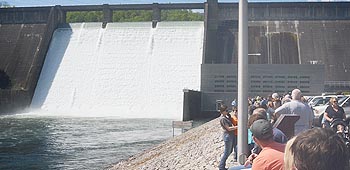Flood control: One of TVA’s most valuable functions

Hundreds of people showed up — some from as far away as Virginia — when TVA opened the gates of Norris Dam on April 25. It had been four years to the day (April 25, 2013) since the gates at TVA’s first dam were opened because of high water levels in Norris Lake.
With water spilling over the dam and generating hydroelectric power it’s easy to forget one of the most valuable functions of Norris Dam: flood control.
Without Norris Dam, the City of Clinton and much of Anderson County would have been devastated by recent heavy rains, according to Travis Brickey, senior program manager for the Tennessee Valley Authority.
A couple of weeks ago six - seven inches of rain fell across the region.
“We put 11 feet of water in Norris Dam over the course of four or five days in an effort to hold it [flood waters] back off of downstream communities and we were able to prevent flooding here in Clinton to the tune of about $1.2 million in damages. Without the dam the flood rate would have been much higher,” he said.
The weather forecast center has computer models which can mimic the river systems without the TVA dams, explained Tom Barnett, Manager of the TVA River Forecast Center.
“That’s how they get that number - how high the water would have been here in Clinton if not for TVA operations,” he said.
According to TVA, the average rainfall is 52 inches per year in the Tennessee Valley — roughly an inch per week. Runoff occurs when there is more water produced by rainfall than the land can absorb. Once the ground is saturated, the excess water flows across the surface of the land into nearby lakes and streams.
“We’re normally up here talking about summer fill this time of year. Well, we’re full,” Brickey said.
As of last Tuesday, Norris Lake was 5.5 feet above fill level and water was still being released at Norris Dam at twice the rate of what TVA would usually release - about 18,000 cubic feet per second.
He said he anticipated the continued release of that amount for several more days but did not specify a day in which the release would end.
In recent years TVA has had to contend with extreme conditions in each direction. The driest runoff year was 2007 in which there was nine inches of observed runoff — 22 inches is the normal runoff. In October 2016 the observed runoff was only 0.03 inches, the lowest monthly runoff ever observed for any month of the year.
In 2013, TVA saw the most rainfall in the eastern Tennessee Valley when 65.54 inches of rain fell. That year 185 million megawatts of electricity was generated, enough to power 1.2 million homes for an entire year.
While the recent release will not approach those numbers, it will mean an increase in the amount of hydroelectric power generated.
“We were dragging because 2016 was really dry so we were well below normal on hydro production, about 60-65 percent of normal for the fiscal year. This is going to help us out. We’re running at maximum capacity at most of our plants right now. We’ll pass that along in fuel cost adjustment that we put out every month,” Barnett said.


